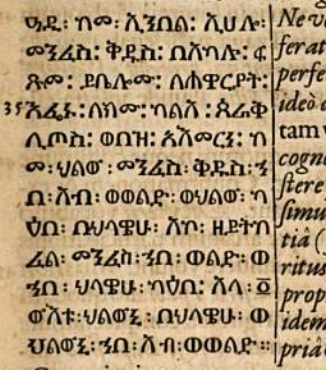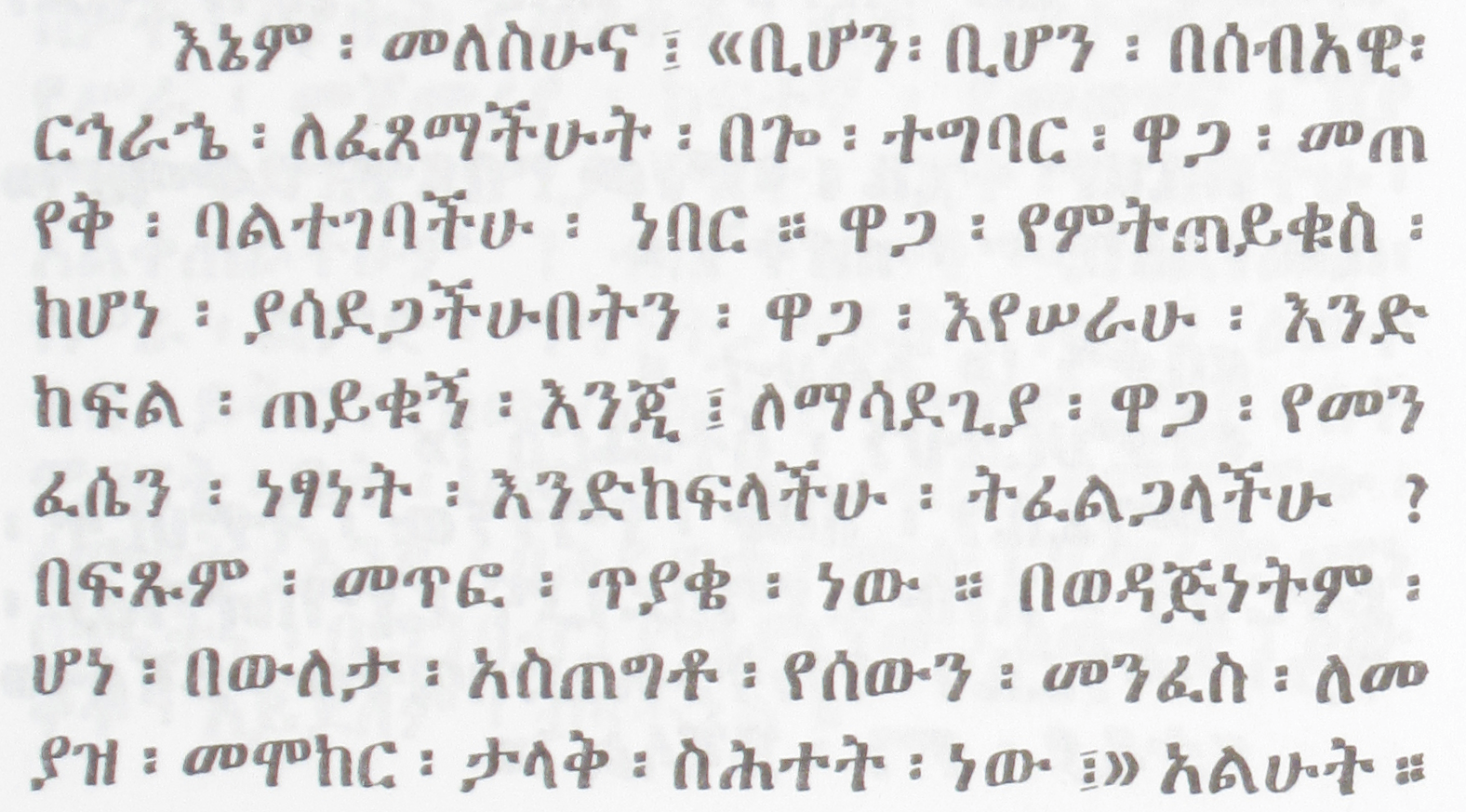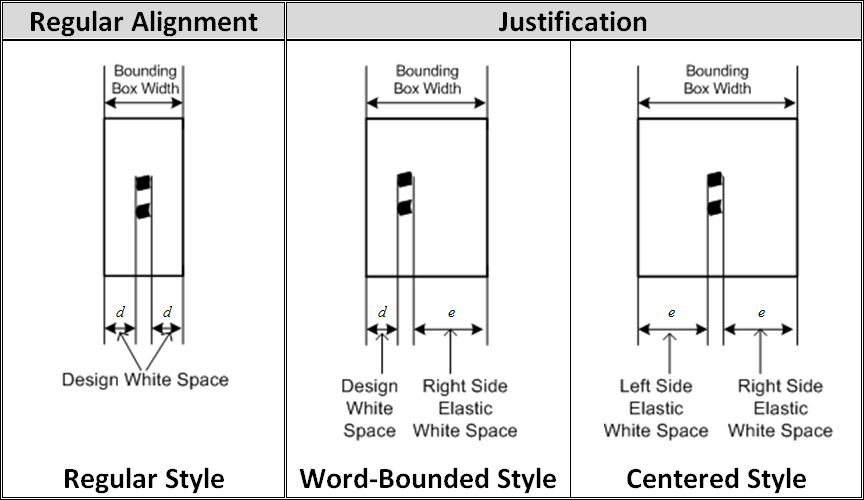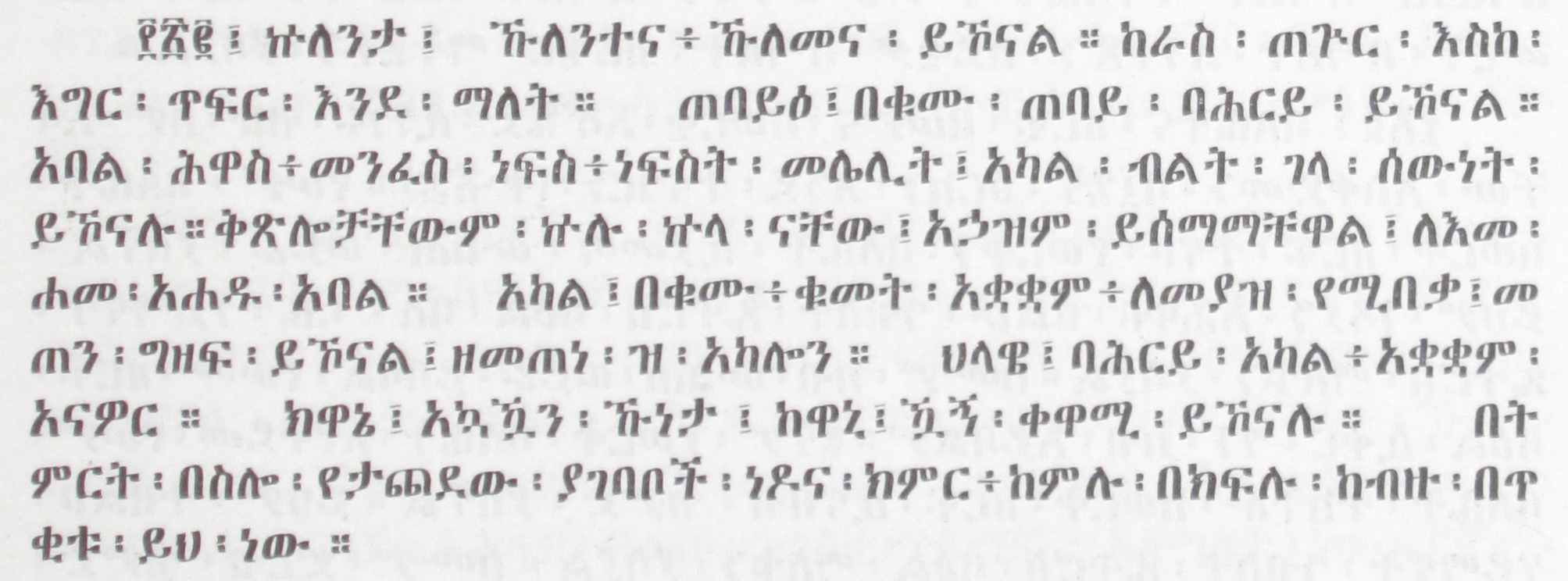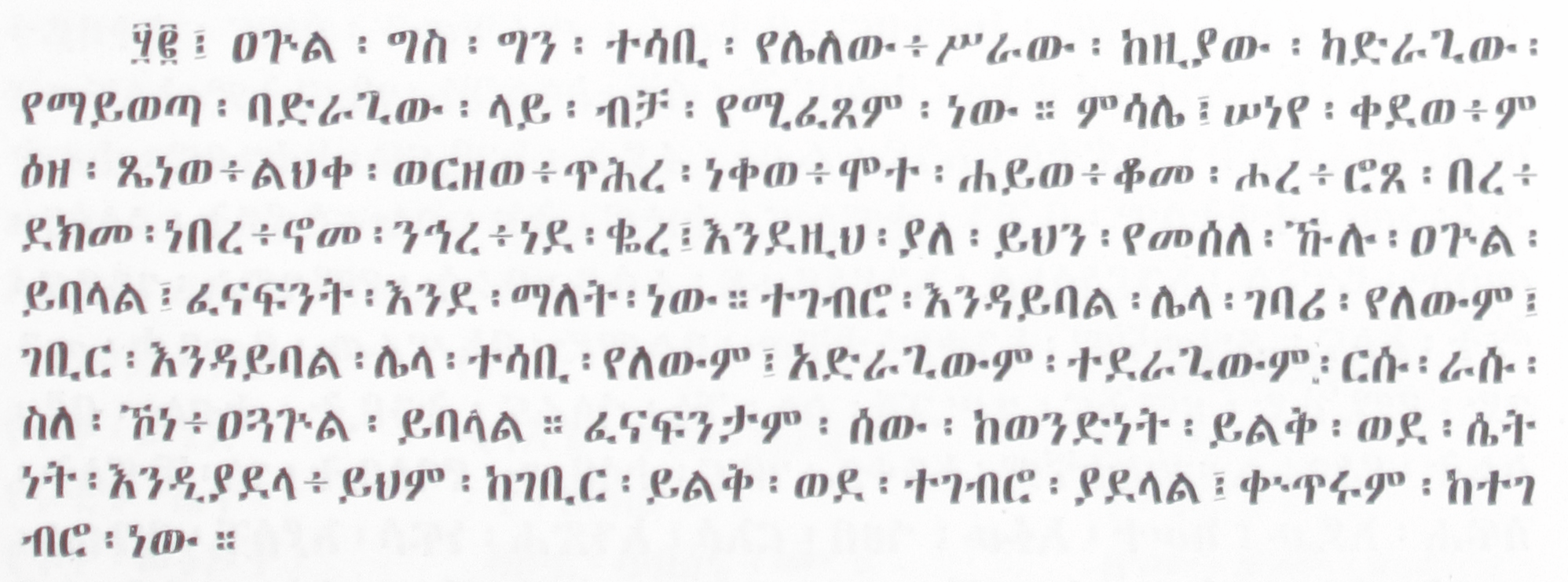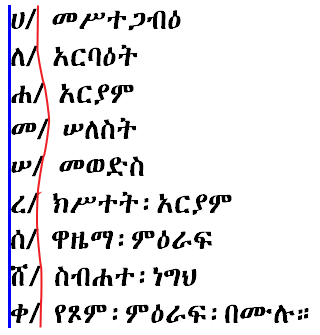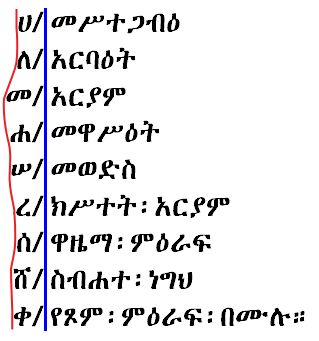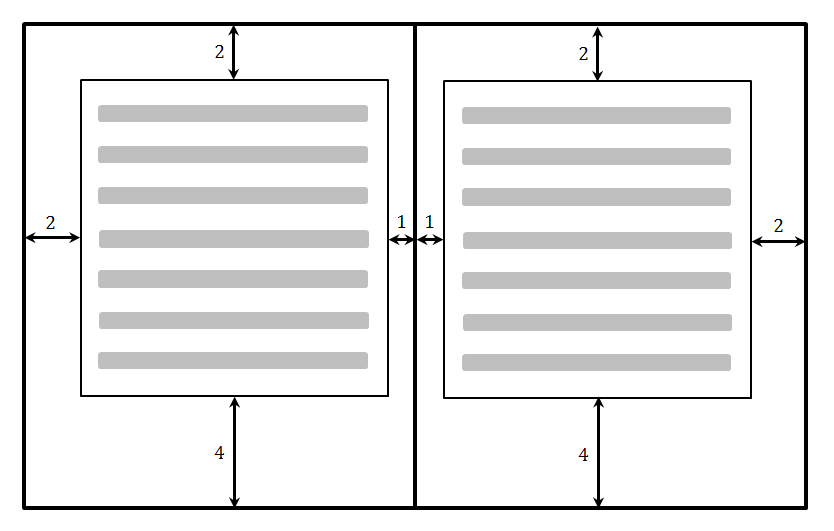Characters & Phrases
Interlingual Documents with Ethiopic
Relative Character Heights
In multilingual documents, differences between the heights of letters in Ethiopic script and its companion foreign script are often found. The difference is likely an artifact of the typesetting technology in use and does not represent the intent of the author or publisher. In the classic typeface style of Ethiopic script the letters will be of variable heights. Fixed height styles are more generally used for advertisement and not publishing. The nature of variable height Ethiopic letters is a factor that complicates how to best align letter height with a foreign script.

At a given point size, letter heights within a script may vary widely between typefaces. This adds another level of difficulty to aligning heights between scripts as an alignment will only be optimal between a specific typeface pair. Within a script featuring variable (not fixed) height letters the relative heights of letters are subject to change between typefaces. This phenomena reinforces the previous assertion on typeface pair optimization, but also introduces the possibility that alignment optimization can be language sensitive. This happens when an alignment pair designed for the letter inventory of one language is applied to another language that includes letters that exceed the heights of the optimized set.

The relative heights of letters used in different languages may also change with typeface as this next figure illustrates.

With these caveats considered, “Zen” alignment is a means to optimize an Ethiopic-Latin typeface pair that is suitable for a general use case when priori knowledge of a document language is unknown. Its basis is reviewed here. The Latin letter “Z” and Ethiopic letter “ን” are chosen as pairing symbols representative of the mean height . They both feature broad horizontal strokes that are easy for the eye to follow as a nearly continuous stroke. Ethiopic letters that were introduced as an extension to the Ge’ez core will typically feature a macron or other modifier at the top of a base letter in order to form the extension letter. The macron necessarily extends the height of a letter. Using the top of the macron for the reference height of a letter leads to height alignment that makes the majority of Ethiopic letters appear too short against Latin letters.

A better approach is to align Z with caron (Ž) against ን with macron (ኝ) while aligning and Z with ን and find typefaces with a good tuple of aligned pairings.

Going further, we may assume that the ኝ and Ž will align satisfactorily (optionally check any irregularities) and simply align the Z-ን pair. Phonetically the sequence of these two letters would sound like “zen”, hence the name.

Issues/Questions:
- Does Z-ን alignment seem reasonable?
- If not Z-ን alignment, what Ethiopic letter should be applied as a height reference point for alignment? Or what other height alignment basis should be used?
- Should height alignment be attempted as per the letter inventory of a target language or for the script as a whole (practical but less optimal)?
- Relative to a Latin uppercase letter, should the height of Ethiopic letters: (a) equal (b) shorter (c) taller?
- Is height alignment an issue with other writing systems? If so, how is it addressed?
Relative Typeface Weights
A common practice in Ethiopic literature is the change of typeface weight in one script to appear more visually similar to the other. Most typically a Latin typeface will be made heavier to better match its Ethiopic counterpart. This weight increase is demonstrated in many Ethiopic fonts that include Latin letters. The font designer may have increased the weight of the Latin range primarily to provide heavier weight punctuation to use with Ethiopic script (see Ethiopicized Punctuation).
Literature produced with a heavier Latin typeface may represent the author’s stylistic sensibilities but, in some cases, may only be a pragmatic outcome when an author finds manually changing between fonts too burdensome. The view of professional publishers is unknown here and should be determined.
Issues/Questions:
- When publishing in the classical Ethiopic weight, should English words appear in their default English weight?
- If heavier Latin letters are desirable, how much so? Can a weight increase be defined as a percentage of the Ethiopic?
Baseline Alignment
It is not uncommon to observe mid-sentence baseline changes in interlingual documents produced with pre-digital typesetting systems where Ethiopic and Latin text, for example, would appear to be laid out along different baselines in a line of text. The most common example of this appears in documents produced with a typewriter where a sheet of paper had to be moved between typewriters to produce a line in two scripts. An apparent baseline difference here would be the result of mechanical misalignment.
Note: The only point that seems can be made here would be to state that Ethiopic and foreign scripts should share the same baseline. This may already be the case with computer typography. If so, this section should be removed.
Sebatbeit Glyph Preferences
The Sebatbeit (aka Sebat Bet) language features a greater number and frequency of labiovelarized letter forms in comparison to the larger language communities utilizing Ethiopic script. In Sebatbeit publishing a number of modifications to diacritical marks are regularly applied to aid glyph clarity. These modified glyphs will sometimes appear within in font as a Stylistic Alternative or an entirely separate font may be used in publishing where these letter shapes appear as the default forms. The glyphs are enumerated here and are recommended for Sebatbeit literature.
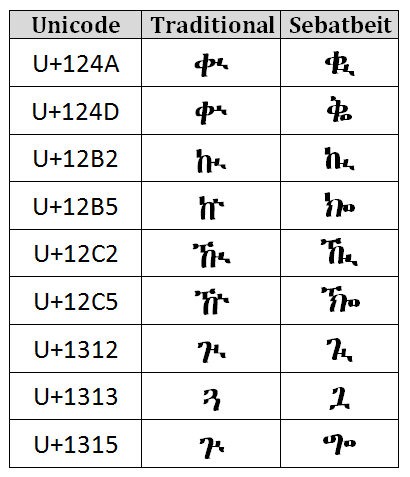
Issues/Questions:
- Do any parties publishing in Sebatbeit disagree with these letter shapes?
- Are any other glyph changes known for other languages?
Punctuation
Punctuation Used in Ethiopic
In Classical era Ethiopic up to nine punctuation marks can be found. Though rarely, if ever, would all nine be found in a single document. The Classical Ethiopic punctuation inventory may appear to be larger in number as a result of bi-chromatic rendering which can be applied to any punctuation and in several different styles. However, the bi-chromatic forms do not change the syntactic role of a given punctuation. In the Modern era, a third of the punctuation marks: ፧, ፨, and ፠ have largely fallen into disuse while a number of punctuation marks from Western practices have been adopted. Bi-chromatic punctuation is now reserved for spiritual materials and remains a calligraphic practice.
Ethiopic punctuation segments text and is non-enclosing. The Ethiopic word separator, labeled “Ethiopic Wordspace” in the Unicode standard, is given special attention in this section as follows more complex rules of interaction with other punctuation as well as justification. Ethiopic punctuation is often aligned with similar English punctuation though these associations must be understood as approximate. Ethiopic fullstop and wordspace are highly regular in their application, others, particularly ፣, ፤, and ፥ will be consistently used within a document but their roles may change between authors or institutes. A detailed review of punctuation semantics is beyond the scope of this document, however Ethiopic comma is given special attention in the following section.
The following descriptions of Ethiopic punctuation usage has been translated from Gebre and Shewaye.
| Symbol | Address | Names | Usage |
|---|---|---|---|
| ፡ | U+1361 | Ge’ez: ንዑስ ነጥብ Amharic: ሁለት ነጥብ Tigrinya: ክልተ-ነጥቢ English: Ethiopic Wordspace |
Literally “two dots” or “two points”. This mark is used to separate words. Since the rise of digital publishing the mark is primarily applied today in a handwritten document. |
| ፦ | U+1366 | Ge’ez: አስተአምሮ Amharic: አስረጂ ሰረዝ Tigrinya: English: Ethiopic Preface Colon |
This mark is used following clarification of a certain subject. It will preface validation statements and examples that support the clarification. |
| ፣ ፥ | U+1363 U+1365 | Ge’ez: ነጠላ ሠረዝ Amharic: ነጠላ ሰረዝ Tigrinya: ንጽል ጭሕጋር (ንጽል ሰረዝ) English: Ethiopic Comma |
Often used to separate comparative and sequential list of names, phrases, or numbers as well as to separate parts of a sentence that are not complete by themselves. A special note of explanation is needed here. While the Unicode standard refers to “፥” as “ETHIOPIC COLON” the correlation with “colon” from Western practices as the name implies can given the wrong impression over the functional role of the symbol in writing. Noted writing experts Desta Tekle Wold, Kidane Wolde Kifle, Dereje Gebre, and Tesfaye Shewaye all assert the equivalence of the two symbols; a shared view that reduces the two symbols to simple glyph alternatives of one another. There is some observed tendency to use “፥” glyph more frequently in religious works, thus to distinguish the two in discussion the “፥” glyph will be referred to in this document as either ንዑስ ሠረዝ or ecclesiastical comma |
| ፤ | U+1364 | Ge’ez: ዐቢይ ሠረዝ Amharic: ድርብ ሰረዝ Tigrinya: ድርብ ጭሕጋር English: Ethiopic Semicolon |
To separate equivalent main phrases in one idea. Even though it is not placed at the end of a paragraph, it can be used to separate sentences with similar ideas in a paragraph. |
| ፧ | U+1367 | Ge’ez: ሠለስተ ነጥብ Amharic: ሦስት ነጥብ Tigrinya: ምልክት ሕቶ (ትእምርተ ሕቶ) English: Ethiopic Question Mark |
Used at the end of the questioning sentence. In modern writing “?” is preferred. |
| ። | U+1362 | Ge’ez: ዐቢይ ነጥብ Amharic: አራት ነጥብ Tigrinya: ኣርባዕተ ነጥቢ English: Ethiopic Fullstop |
This mark is placed at the end of the sentence that describes the completeness of an idea. |
| ፠ | U+1360 | Ge’ez: Amharic: Tigrinya: English: Ethiopic Section Mark |
Used to divide sections or subsections; generally three or more used together on a line of their own. |
| ፨ | U+1368 | Ge’ez: Amharic: Tigrinya: English: Ethiopic Paragraph Separator English: Ethiopic Seven Dot Section Mark |
May be used to conclude the final paragraph of a section in lieu of Ethiopic Full Stop. May also be used under the same rules given for Ethiopic Section Mark. |
Adopted into Ethiopic writing practices are enclosing punctuation such as parenthesis, brackets, single and double quotation marks and guillemets. Expressive punctuation such as question mark, exclamation point, inverted exclamation mark, and ellipsis are also incorporated into Ethiopic practices. Additional foreign symbols that denote currency, time, mathematics, or communicate with Internet protocols (e.g. "@" , "://") have also been adopted as over the last century as international communication grew.
The ES-781:2002 standard identifies the following inventory of western symbols to be used with Ethiopic:
1234567890 ? ! ¡ . / () [] {} < = > \ # % & _ - + ± × ÷ ‘ ’ “ ” ‹ › « »
Additionally the following punctuation is observed to be used with Ethiopic writing:
$ : , € @ …
Inverted exclamation mark is repurposed and utilized differently than in its Western usage. In Ethiopic writing the inverted exclamation mark is known as “Timirte Slaq” (ትእምርተ፡ሥላቅ) appears at the end of a sentence and will denote sarcasm. All borrowed punctuation is subject to typeface alignment with Ethiopic weights and shapes, an aesthetic enhancement discussed in this section as “Ethiopicized Punctuation”.
Ethiopic Comma Usage
In Ethiopic writing practices three encoded symbols will be used in the context of comma, however they are generally not used together. Looked at another way, the Ethiopic comma may appear with three different glyphs. The western comma also has an important role in Ethiopic writing. Usage rules are as follows:
- ፣ - ነጠላ ሠረዝ
- U+1363 ETHIOPIC COMMA (አማ/ ነጠላ ሠረዝ, ትግ/ ንጽል ሰረዝ) is used as a comma in Ethiopian practices and as a semicolon in Eritrea. “፣” will also be used in Ge’ez writing as a semicolon (is this a modern usage or classic?). U+1364 ETHIOPIC SEMICOLON, ፤, in turn is used as a colon in Eritrean writing (verify).
- ፥ - ንዑስ ሠረዝ
- U+1365 ETHIOPIC COLON in contrast to its Unicode name, is never used as a colon in any known Ethiopic practices. Rather, it is a classical glyph variant of U+1364 ETHIOPIC SEMICOLON (፣). ፥ is the default comma glyph in Ge’ez writing and is the preferred comma glyph by some modern writers writing in other languages. ፥ is the default comma in most Amharic bibles, likely in keeping with the Ge’ez Bible that the Amharic would have been translated from. Some modern Bible translations into Amharic, as well as other religious literature, will use ፣ as the default comma in prose but maintain ፥ for passage references, e.g. ማቴ4፥23 , ዮሐ13፥16 , etc. Given this common usage in religious materials “ecclesiastical comma” is a practical English term for referring to the ፥ glyph variant. As mentioned already, writing experts Desta Tekle Wold, Kidane Wolde Kifle, Dereje Gebre, and Tesfaye Shewaye all attest to the equivalence of the two symbols.
- ፡ - ንዑስ ነጥብ
- U+1361 ETHIOPIC WORDSPACE (አማ/ ሁለት ነጥብ, ትግ/ ክልተ ነጥቢ) in keeping with Ge’ez heritage, is used as the word separator (i.e. space) in the classical writing practices of both Eritrean and Ethiopia. In modern Eritrean writing practices ETHIOPIC WORDSPACE will be used in the role of a comma (illustrated in Figure ). When used in modern Ethiopian writing, it retains its classic role as word separator (space). See for elaboration on this topic.
- , - comma
- U+002C COMMA is utilized in Eritrean and Ethiopian writing practices in the formatting of western numbers only.
Issues/Questions:
- Are the above descriptions correct?
- Should authors be able to set a default comma (፣,፥,፡) in software?
- Should authors be able to set a default space symbol in software?
Ethiopic Wordspace in the Context of Comma
In recent decades some communities have adopted a practice of employing the wordspace symbol as a comma when U+0020 SPACE [ ] is used as the word separator. The interpretation of the symbol is then dependent on the context of the writing convention in use by the author. Accordingly, an application user setting could be offered to set the symbol context.
An alternative view point on this practice is that U+1363 ETHIOPIC COMMA [፣] is in fact in use by these user communities; however its glyph has decayed whereby the line segment is lost and so it visually coincides with U+1361 ETHIOPIC WORDSPACE [፡]. Under this perspective, a simple solution would be modify an Ethiopic font for these users (perhaps adding an alternative glyph in an OpenType stylistic set) where the Ethiopic comma character address and semantics remain intact though the visual form has been tailored to meet aesthetic needs.
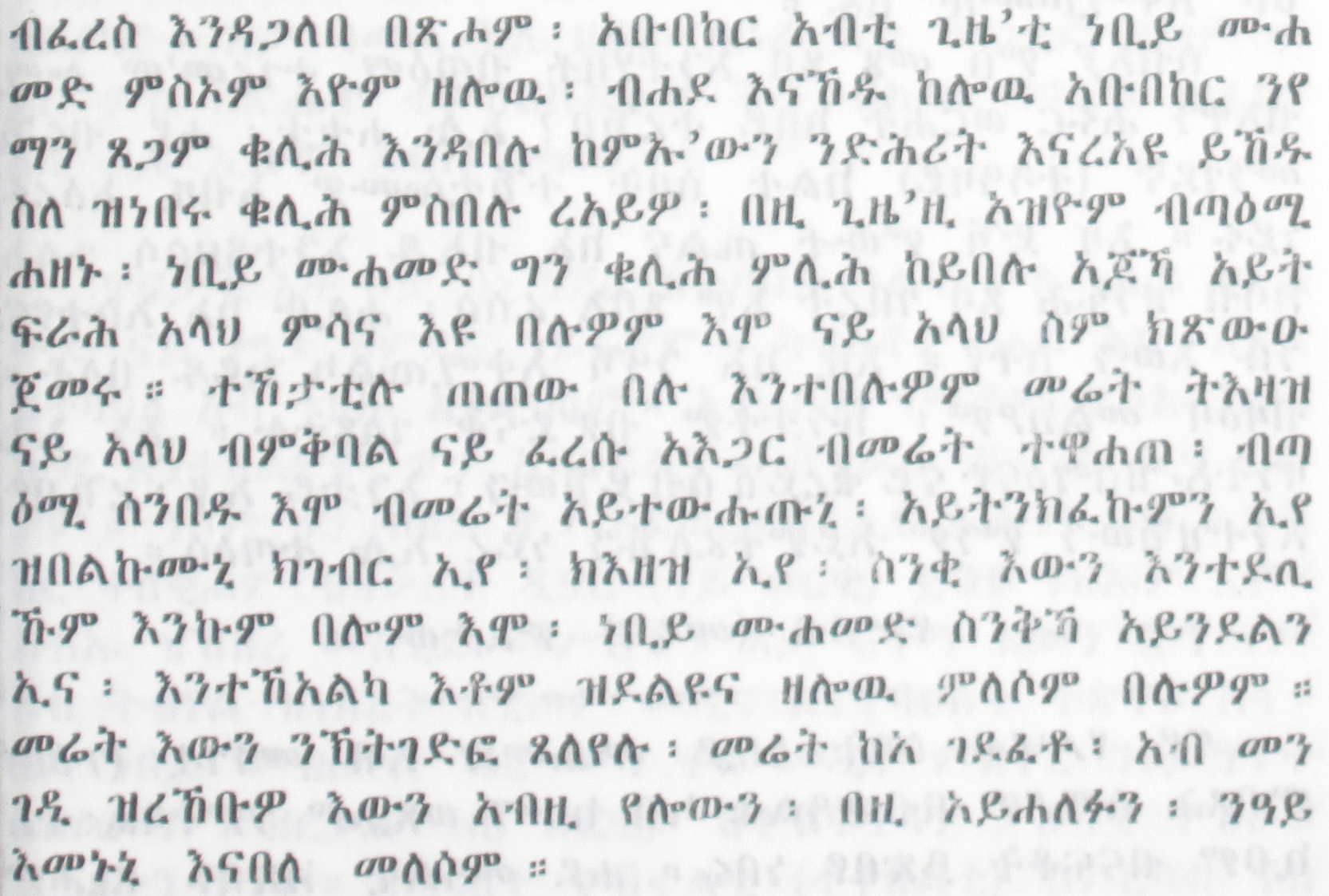
Issues/Questions:
- Should comma context be a user preference?
- Not an issue but a note; an author of this document recommends strongly preserving the symbol semantics of Ethiopic Wordspace and not overloading it with the semantics of Ethiopic Comma. Doing so simplifies spacing rules for the Wordspace symbol as the comma usage context will not need to be addressed. Applying the “decayed glyph” perspective as an alternative glyph in a font is preferred as it mitigates the semantic overloading.
Ethiopicized Punctuation
The shape and weight of adopted symbols are often changed for a better visual fit with an accompanying Ethiopic typeface. Enhanced foreign symbols are referred to here as “Ethiopicized”. While many symbols are borrowed from western writing, not all necessarily benefit from Ethiopicization. Those that do will primarily be used in a context where the foreign symbol directly abuts some Ethiopic symbol. Common Ethiopic symbols are demonstrated in the following figure:

Issues/Questions:
- Are there any additional western symbols required for Ethiopic writing?
- Are any symbols from other foreign script (Chinese, Arabic, etc.) that should be included?
- What symbols benefit from shape change?
- What symbols benefit from weight change?
- Noteworthy for layout correction is that an isolated left double guillemet, », is common in tabular text to indicate that the entry above is to be duplicated. This is a use case where the left double guillemet is not required to be balanced by a right double guillemet (“ትእምርተ፡ደጊመ፡ቃል፡” context).
- Are square “dots” in punctuation preferable over circular?
Optical Balancing
Foreign language words or phrases are regularly found inline within a paragraph of Ethiopic text, often bounded within enclosing punctuation such as brackets and quotation marks (e.g. []()""''«»‹›). This practice is most often observed in news articles on international topics. The weight of the enclosing punctuation may be found as matching either the Ethiopic or Latin weight. The preference of stakeholders must be determined here. Comparative samples follow:




As a rule within the embedded foreign script, the weight of punctuation and other symbols (numbers, etc) should be in keeping with the weight of the foreign text and not that of the surrounding Ethiopic.
Issues/Questions:
- What do stakeholders feel should be the default weight for enclosing punctuation?
- Would preferences change if Ethiopic wordspace were applied in the samples?
Ethiopic Wordspace Alongside Other Punctuation And Line Breaks
It modern literature where punctuation may be borrowed from Western writing, inconsistent formatting practices are found with respect to the presence of Ethiopic Wordspace (፡) alongside borrowed punctuation. It is helpful to establish rules for Ethiopic Wordspace in the presence of other symbols so that software grammar and formatting checkers can offer corrections leading to better quality and more consistent literature. The following rules are proposed:
- A letter or number may border either side of Ethiopic Wordspace.
- Ethiopic Wordspace may appear before, but not after, an opening punctuation, such as: ( , [ , { , « , ‹ , “ .
- Ethiopic Wordspace may appear after, but not before, an closing punctuation, such as: ) , ] , } , » , › , ” .
Example:
Incorrect: … ፅፋት፡(ፅፍዓት፡)፡ከመ፡ኪደተ፡ንስር፡(እንደ፡አሞራ፡ፈጣን፡)።
… ፅፋት፡(ፅፍዓት፡)ከመ፡ኪደተ፡ንስር፡(እንደ፡አሞራ፡ፈጣን፡)።
Correct: … ፅፋት፡(ፅፍዓት)፡ከመ፡ኪደተ፡ንስር፡(እንደ፡አሞራ፡ፈጣን)።
- No other punctuation may border Ethiopic Wordspace.
- A new line may follow, but not precede, an Ethiopic Wordspace (a wordspace may not start a new line).
- Whitespace may not follow or precede an Ethiopic Wordspace (note, this does not include stretchable space used in line justification).
- An Ethiopic Wordspace followed by another Ethiopic Wordspace must be interpreted as an Ethiopic Full Stop (።).
Issues/Questions:
- Are the above rules valid?
Space-Wordspace Substitution Rules
Rules are presented here to aid layout software that would offer the functionality of space symbol conversion to and from Ethiopic wordspaces. This functionality is desirable in a viewer application (e.g. web browser, eBook reader) to make the same substitution as per a user preference. Thus the user would be able to read a document with Ethiopic wordspaces that was composed and delivered with white space. Likewise in the reverse, a user who preferred white space could have their preference supported in a document that encodes Ethiopic wordspaces only. Similarly, this functionality would be useful to users of an editor application.
[TBD: Test cases should be developed to validate these rules. Apply screenshots of test cases to help illustrate the requirement that a rule addresses.]
Space to Wordspace Transformation Rules
- White space symbols other than space (U+0020) are not processed. Issue: how should non-breaking-space be handled?
- Space(s) at the start of a line are assumed to be there for positioning and are not processed.
- A sequence of one or more spaces is treated as a single space.
- Space(s) are substituted for wordspace when bounded by letters, or between a letter and number.
- Space(s) are substituted for wordspace before or after enclosing punctuation as per the convention applied in Ethiopic Wordspace Alongside Other Punctuation and Line Breaks.
- Space(s) before or after non-enclosing punctuation are removed.
- Space(s) bounded by non-Ethiopic numbers are not processed.
- A wordspace will be appended to the end of line (a line ending with a hard return) that does not end with punctuation.
Wordspace to Space Transformation Rules
- A sequence of more than two wordspaces is not converted as the author’s intent is indeterminate.
- A sequence of exactly two wordspaces is converted to an ETHIOPIC FULLSTOP (U+1362).
Note: This conversion is suggested as an auto-correct feature. - A sequence of exactly one wordspace is convert to space.
- A wordspace at the end of a line may be removed.
An additional wordspace conversion rule that is independent of the above space-wordspace substitution rules: Very commonly in Ethiopic documents a sequence of two wordspaces are found and may be substituted for Ethiopic fullstop. This may be considered a defect correction rule.
Ethiopic Gemination Mark (ጥብቅ) Vertical Positioning
The Ethiopic gemination mark, ጥብቅ, is almost universally found at a fixed height above the baseline in typeset literature. The mark’s position must then be fixed so that it remains above the tallest Ethiopic letter symbol; this produces a variable height gap between the top of the letter and the mark. Conversely, when the symbol is hand written (often above typeset text) the mark will be found at a variable height above the baseline and demonstrating a fixed height above the letter symbol. Quite possibly the former style is an artifact of a limitation of the layout technology employed, and the later representative of an author’s desired rendering.
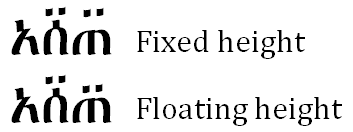
Issues/Questions:
- What do stakeholders feel should be the default positioning style (fixed, floating)?
- The same rules apply to the ETHIOPIC COMBINING VOWEL LENGTH MARK (U+135E) and ETHIOPIC COMBINING GEMINATION AND VOWEL LENGTH MARK (U+135D). Stakeholders here (current or past) should be identified.
- OpenType shaping logic may be sufficient to handle the issue. Thus a specification here might only be utilized by font implementations.
Parenthetical Expressions
Parenthetical expressions are found regularly in modern Ethiopic writing and will apply any of the enclosing symbol pairs: // , () and [].

Issues/Questions:
- What are the preferred parenthetical enclosing symbol pairs for modern writing?
- Do special rules apply for inner expressions?
- Do copy editors or publishers set a policy for parenthesis symbols, or leave it up to the author to decide?
- Of interest: when are parenthesis first found in Ethiopic writing and in what form?
Quotation
Classical Ethiopic literature applying quotation marks will employ double guillemet (« ») in a primary style and single guillemets (‹ ›) in a secondary style. Single guillemets will be used for inner-quotation and single word quotation. Modern Ethiopic writing will additionally utilize Latin quotation marks similarly (“ ” ‘ ’, U+201C, U+201D, U+2018, U+2019). The choice of Latin script quotation may represent either an author preference or a software limitation that made guillemets unavailable or difficult to access.
Issues/Questions:
- What are the preferred quotation marks for modern Ethiopic literature?
- Is the single quotation mark usage statement correct?
- Do any other rules apply to quotation usage in Ethiopic writing?
- Do copy editors or publishers set a policy for quotation mark choice, or leave it up to the author to decide?
- Do the same rules apply for Ethiopic wordspace surrounding a closing quotation mark as with a closing parenthesis?
- Of interest: When are quotation marks first found in Ethiopic writing and in what form?
Ellipsis
Both punctuation-baseline and raised ellipses are found in Ethiopic literature. In Ethiopic publishing ellipsis may have anywhere from 3 to 6 dots used regularly. The presence of one style over the other may simply be an artifact of the publishing technology and not necessarily in line with the publisher's preference.

Issues/Questions:
- How many dots should be in an ellipsis?
- Which ellipsis form is preferred as the default?
- How much spacing between dots is desirable?
- Are square dots preferable over circular?
- What spacing (if any) before and after the dots?
Word Boundaries
Discuss: Do regular rules apply? One consideration for Ethiopic would be that a newline is not a dependable word boundary in the common case where words are split across lines without a hyphen symbol and white space is the default wordspace. Word boundaries are known here only by context.
Discuss: The special case with wordspace sticking to a word leading to the mouse text selection rule that a following wordspace should be automatically selected with text, analogous to the rule applied to white space. MS Word does this.
Formatting of Ethiopic Wordspace
Rules of Applying Whitespace in Ethiopic Text
When Ethiopic Wordspace (፡) is used to separate words, there may still be some valid application for white space “ ”. White space is permissible to support the following formatting needs:
- Indentation.
- Following a counter suffix.
- Within a numeric sequence, like a phone number.
- Within a date format (sometimes, not always).
- Within a scripture reference (sometimes not always).
- Before and following quotation marks.
- Following an ellipsis (?).
- Within a block of embedded foreign script.
[TBD: Image samples needed]
Issues/Questions:
- Are the above rules valid?
- For the above cases where white space is valid, can the spacing width rules applied for Latin text be applied for Ethiopic?
Numbers
Ethiopic Numeral Bars
Sequences of Ethiopic numerals, such as years and page numbers, may be written in one of two styles. In the most common style in modern literature the numerals are written as discrete, independent, symbols. In a second “joining” style of writing, primarily found in calligraphic text and handwriting, the numerals may share a common upper and lower bar. Conceivably the joining style went out of favor as it proved more difficult to support in publishing technology. Modern preferences should be determined from stakeholders.

Issues/Questions:
- What do stakeholders feel should be the default style (joined, isolated)?
- Do stakeholders want the option for both styles?
- Are there any context rules to determine when a given style is appropriate?
Ethiopic Numeral Vertical Alignment
In the Ethiopic numeral system a single symbol may represent a numeral with an order of magnitude in the power of 0, 1, 2 or 4. This feature of the numeral system leads to several potential layout possibilities when numerals are arranged vertically.
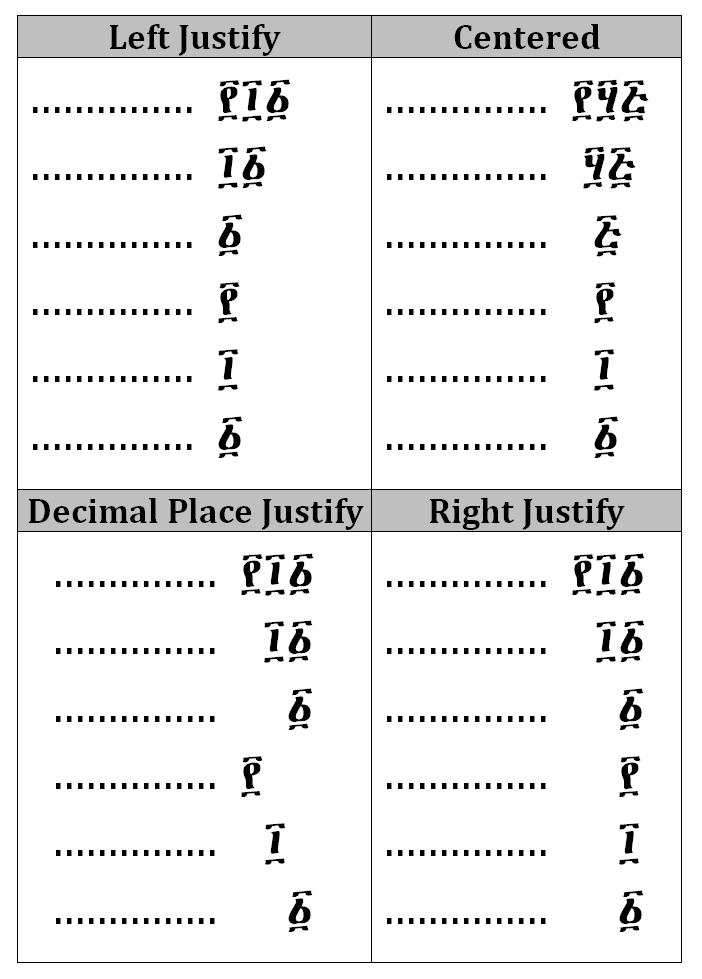
Issues/Questions:
- Are the vertical alignment rules of Roman or Coptic numerals appropriate (and what are they)?
- In what layout context is right justification appropriate?
- In what layout context is decimal place justification appropriate?
- In what layout context is left justification appropriate?
Ordinal Notation
An ordinal is formed in Amharic when “ኛ”, and in Tigrinya when “ይ”, follows a cardinal number. The ordinal marker is often, but not always, rendered in superscript form. The superscript practice is most prevalent with ordinals in western numerals, but is also applied with Ethiopic numerals.
Issues/Questions:
- What letters should be superscripted, and it what contexts? For example, “ሳ” and “ብር” may also be superscripted in presentation of prices but is not common in print (found mostly in store front advertising).
- Are ordinals always superscripted, or is superscript language or locale specific? Should superscript for ordinals be a setting?
- An argument goes that superscript of “ኛ” should not follow an Ethiopic numerals since the counting system is put into a Ge’ez context and Ge’ez literature does not use a superscript. Yet “ኛ” is appropriate to Amharic language and is not a letter found in Ge’ez. The class of literature may be at issue here, such a religious materials.
- What should the height (in percentage) of the superscripted symbol be with respect to the base text?
- How should the superscripted symbol be aligned vertically with the base text?
Emphasis
Classical Ethiopic writing does not feature a letter shape stylistic change to communicate word emphasis. In religious works, the color red will be used to emphasize a spiritual aspect of a word in a passage (i.e. “rubricate”).
Emphasis in modern Ethiopic writing will employ every emphasis device available from the available publishing technology (e.g. underline, slant, embolden, letter size, letter outline, background shapes, etc.). The practice however is idiosyncratic and inconsistently applied leading to debate and disagreement within the publishing community.
The following subsections present a proposed best practice of the authors.
Emphasis Within Prose
Italic applied to Ethiopic has been experiment with since the arrival of desktop publishing. Earlier in the 20th century, a typeface change to a pre-20th century style would be applied in place of italic. Underlined text was introduced to Ethiopic publishing in the earlier 20th century and was well established by mid-century. It is not uncommon to find the underline “Ethiopicized” whereby the weight is made heavier to correspond with the greater weight of Ethiopic letters relative to Western weights.

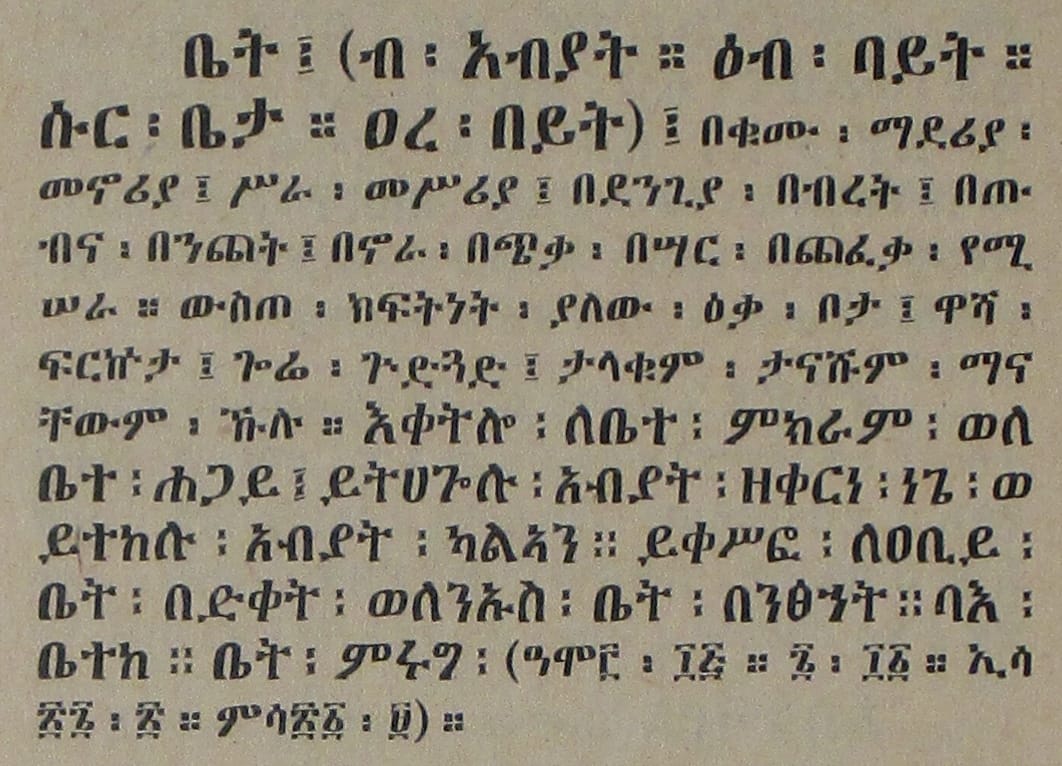

Issues/Questions:
- How much slant when an italic designed typeface is not available? 10% is suggested.
- Should the underline of Ethiopic text use a weight that is proportionally heavier (with respect to the text), or apply only the weight of the word processor?
Ecclesiastical Emphasis
In religious literature, certain words or phrases with a spiritual or more holy aspect may be rubricated (inked in red). The practice is context dependent and a word rubricated in one sentence may not be in the next (or elsewhere in the same sentence).
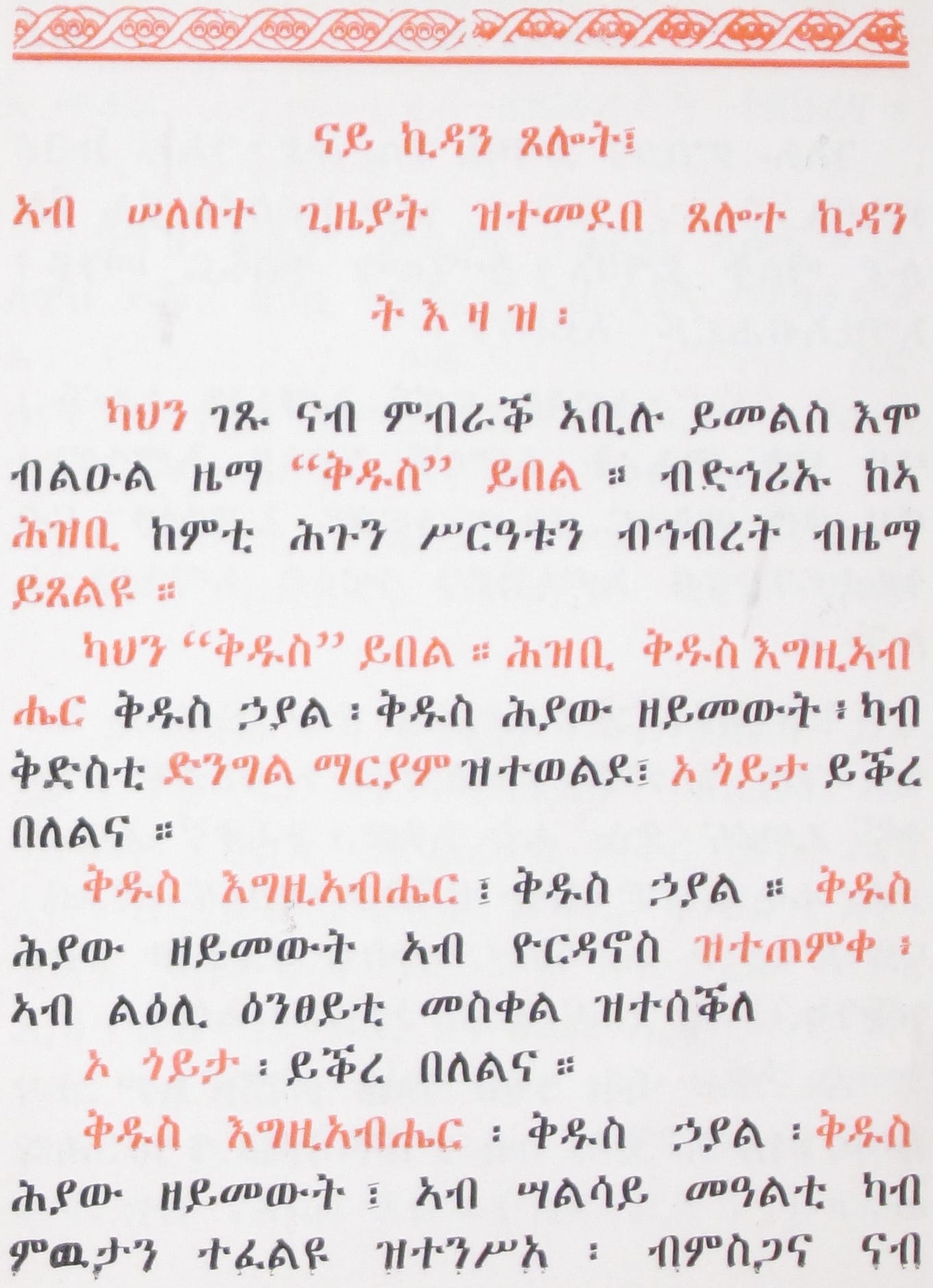
Issues/Questions:
- What shade of red?
- What is the preferred substitute for red when only monochrome publishing is available?
Emphasis With Ethiopic Wordspace
As a rule, a wordspace following a word that is emphasized in some way (color, bold, italic, underline, etc.) shall receive the same emphasis. This is in keeping with the Ge’ez literature tradition.
Issues/Questions:
- Does this rule make aesthetic sense in full justification with wordspace in centered positioning style? In Ge’ez manuscripts no issue arises since little or no white space appears between the wordspace and boundary words. The elastic space around wordspace may stretch considerably in typeset documents, under justification, where continuation of the emphasis may appear peculiar after some stretching threshold width.
- Related: Does word emphasis include a following punctuation?
Abbreviation Formation
Abbreviations in Ethiopic languages will apply an abbreviation marker ("/" or ".") placed between the first letters of each word in a phrase. In a multi-word abbreviation, the last word may sometimes remain whole. Abbreviation of a single word will keep the first and final letters of the word separated by slash “/”. Classical literature that uses the Ethiopic Wordspace may not use an abbreviation marker and instead will rely on the Ethiopic Wordspace to separate initial letter abbreviations that will be understood from context: (e.g. ዓመተ፡ምሕረት፡ ⇒ ዓ፡ም፡).
Examples:
Single Word
ሚኒስትር ⇒ ሚ/ር
ሆስፒታል ⇒ ሆ/ል
Multi Word
ጠቅላይ ሚኒስትር ⇒ ጠ/ሚ/ር
ኢትዮጵያ ኦርቶዶክስ ተዋሕዶ ቤተ ክርስቲያን ⇒ ኢ/ኦ/ተ/ቤ/ክ
Issues/Questions:
- When “.” is used as the abbreviation marker, it is sometimes found at the end of the abbreviation.
- Confirm single word abbreviation rule.
- Are mixed abbreviation markers appropriate? Some well-established abbreviations apply a “.” as the marker, for example “አዲስ አበባ ዩኒቨርሲቲ” becomes “አ.አ.ዩ”. This may reflect the chosen convention of the institute.
- What symbol is applied for foreign words transcribed into an Ethiopic languages?
- Do copy editors or publishers set a policy for abbreviation, or leave it up to the author to decide?
- Of interest: when are abbreviations first found in Ethiopic writing and in what form?
Letter Spacing
Any number of kerning pairs and ligatures are possible for Ethiopic typography that would lead to better visual quality of printed literature. While beyond the present scope of this task force, raising the topic with stakeholders to gauge the level of interest would be beneficial to help set the direction of future work.
An assumption here is that ligatures are only relevant to the reproduction of calligraphical manuscripts and not a requirement of modern literature.
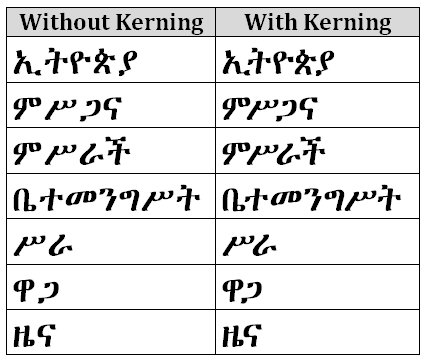
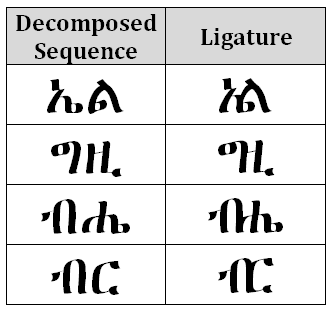
Issues/Questions:
- Is defining kerning pairs of interest to your organization?
- Is defining ligatures of interest to your organization?
